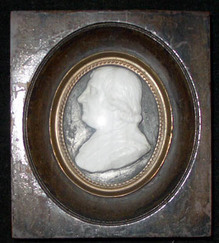James Tassie (1735-1799), John Witherspoon, 1723-1794, no date. Wax cameo. Museum Object collection
John Witherspoon (1723-1794) was the sixth president of Princeton, a signer of the Declaration of Independence, and from 1776 to 1782 a leading member of the Continental Congress. He came from Scotland in 1768 to assume the presidency of the college and held office until his death a quarter of a century later.
With their five surviving children … and 300 books for the college library, the Witherspoons reached Philadelphia early in August 1768. When a few days later they moved on to Princeton, they were greeted a mile out of town by tutors and students, who escorted them to Morven, home of Richard Stockton. That evening the students celebrated the occasion by “illuminating’ Nassau Hall with a lighted tallow dip in each window.
…Witherspoon lived at first in the President’s House (now called the John Maclean House), but after several years he moved about a mile north of the village to Tusculum, a handsome residence he built that still stands on Cherry Hill Road. His route to and from the College is well enough indicated by the street that bears his name.
…Though a man of strong convictions, he showed no inclination to protect his students from exposure to ideas with which he disagreed. The many books he added to the library gave the undergraduate access to a wide range of contemporary literature, including authors with whom he had publicly disputed. In his famous lectures on moral philosophy, not published until after his death and then probably contrary to his wish, his method was to lay out contending points of view and to rely upon persuasive reasoning to guide the student toward a proper conclusion of his own. —W. Frank Craven from Alexander Leitch, A Princeton Companion, copyright Princeton University Press (1978).
